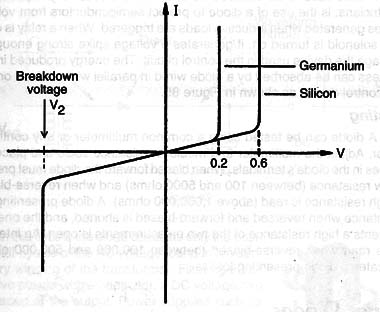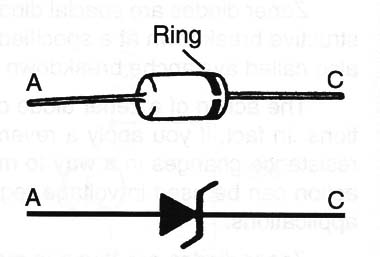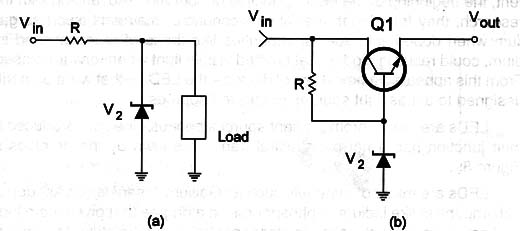
Zener diodes are special diodes that are processed to have a nondestructive breakdown at a specified value of the reverse voltage.
They are also called avalanche breakdown diodes or breakdown diodes.
The action of a zener diode can be used in many electronic applications. In fact, if you apply a reverse voltage to a zener diode its reverse resistance changes in a way to maintain constant voltage across it.
This action can be used in voltage regulation, to clip signals, and many other applications.
Zener diodes are found in many types and sizes in electronic equipment. For the reader, it is important to know how a common diode can differentiate from a zener diode.
Although they look the same, the way they are positioned in a circuit, the identification number, the symbol in the schematics, or any other specific information may differ.
Symbol and View
Figure 2 shows the symbol and a view of a common zener diode as the reader will find them in electronic circuits.

Since zener diodes are polarized components, there must exist some identification for the poles in the component. It is usual to place a ring or strip at the cathode side of the component.
The size of the zener diode is determined by the amount of current it can control or the range of currents in which the diode can keep the voltage constant.
Specifications
The zener diode manufacturers used to indicate their products by a part number.
So, a handbook with the main types or another kind listing of their characteristics is fundamental in order to know what they are.
When replacing a zener diode without having the part number it is important to know two specifications:
1. Zener Voltage: the breakdown voltage or the voltage the device is designed to keep constant when reverse-biased. Zener diodes are made with voltages in the range between 1 and 2 volts to more than 100 volts for typical types found in domestic and industrial appliances.
2. Dissipation Power: the maximum amount of current flowing across a zener diode during operation. The zener voltage gives the dissipation power or the amount of electric power that the device can convert in heat. The larger the size of the device, the larger the dissipation power. Typical values are between 400 mW and 10 W.
Where they are found
Figure 3 shows some circuits where zener diodes are found. In (a) is a simple voltage divider in a simple power supply where the zener diode maintains a constant voltage in the load plugged into the output.

A more complex power supply is shown in (b) where the transistor controls the amount of voltage applied to the load.
This voltage is kept constant by the action of the zener diode placed at its base. How the transistor works in a circuit like this is discussed when explaining how transistors work.
Other applications of zener diodes include voltage reference voltage in instruments and signal clipping circuits.
Testing
The simplest way to test a zener diode uses a common multimeter on the lowest resistance scale. The zener diode is tested as a common diode; when forward-biased it must present a low resistance (100 to 10,000 Ω), and when reverse-biased it must present a high resistance (above 1,000,000 Ω).
This test doesn’t show anything about whether the zener voltage is altered or not. It is important to remember that this test is valid only if the zener voltage of the tested device is lower than the voltage used by the multimeter in the probe.



